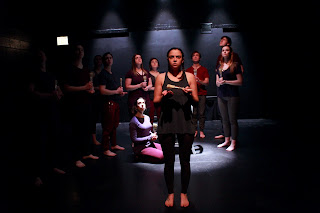Once upon a time I went to a show and it was called 4.48 Psychosis. It was by Sarah Kane and it was directed by Brian Fruits. It was about depressed people talking about their insecurities and their thoughts of suicide. The script of this play has no stage directions or assigned dialogue or specified characters, so every production is different. The first production only had three people, and this has an ensemble of 12 people (Alli Braun, Dane Van Brocklin, Carly Crawford, Lauren Demerath, Gavin Farrow, Kevin Garrett, Brian Bengston, Alison Call, Anne Ogden, Lauren Partch, Bryce Saxon, and Ryan Smetana). It reminded me a lot of performance art because of the artificial way that they moved, the way they would often be in their own universe and then start to notice each other, and they also often spoke directly to the audience. I feel like this is a valid way to do this show, but I would have been more interested in seeing them try to create 3 or 4 consistent characters throughout the play, rather than many actors being assigned speeches almost at what felt like random.
I feel like this piece had a lot of interesting images. At the beginning, each person was entering one by one. And they were doing a repetitive movement at different tempos. And then the last person walked in, and everyone started turning towards her. And she went to the wall and started doing the same repetitive movement that most of them had been doing before, but on the wall. And then they all started making a motion like they were using a paintbrush. One of my favorites images was when, at the end of the play, they actually painted on the wall. They all dipped in their paint brushes, and at first it seemed like they were just making random shapes. But then it started to turn into letters that read "Please open the curtains." It was really moving to see all these people working together to make one big thing at the beginning and end of the play. For a lot of the rest of the play, they were not working together. They might help lift someone, or engage with someone, but these were the times they were all doing an equal thing together, which was really cool visually and emotionally. There had been these tiny little curtains at the bottom of the wall, which I though was there for no reason, but it turned out they had a purpose to make a statement at the end.
I think that more consistent and defined characters would have helped make everything a little bit more understandable. It is different when you have complex characters that you get to know and understand how and why they are depressed. If you don't know someone and they just come up and start yelling about their depression and how much they hate their genitals, it is harder to feel compassion for them. I'm not saying that depression has to have a cause. A lot of depressed people feel depressed because they just are. They don't have a reason for it; they just are. But it still helps to know the context of their lives and not have their depression reduced to just statements. I know that suicide and depression are very serious topics, and the ensemble treated these statements respectfully. The only way it feels right to feel about this is to feel bad. I wasn't expecting it to be uplifting, but I was expecting more levels in the way I responded. I expected it to be heartbreaking, but not relentlessly depressing. That might be what the playwright was going for, but that isn't what I look for in theater.
People who would like this show are people who like performance art, ensemble pieces, and painted messages. I think there were some really beautiful moments in the show and it was performed with a lot of passion.
Photos: Corwyn Cullum


No comments:
Post a Comment